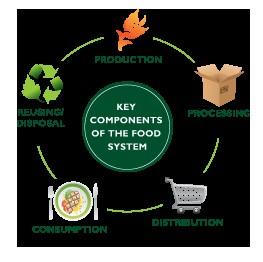

Risk Management Applied to Food Safety Security and Sanitation
I. INTRODUCTION TO RISK MANAGEMENT APPLIED TO FOOD SAFETY, SECURITY AND SANITATION
Food safety, sanitation and hygiene are essential to the global promotion of health and awareness. This has been an ultimate concern of agencies and organizations around the world. Accessibility to various food and beverage brought satisfaction and anxiety to many. It must be clean and in an acceptable state, however numerous malpractice of handling food, leads to compromise its safety.
Creating a safe, secure and healthy environment is essential to pursue learning, work promptly and perform activities. Safety, security and risk management are in charge of operations, emergency preparedness and planning, as well as occupational health and safety. Risk management is an important element in managing an organization, whether in the private or public sector, indeed it enables risks and opportunities to be actively monitored and controlled. Systematic and comprehensive risk assessment provides a reliable basis for decisionmaking processes.
II. OBJECTIVES.
Specifically, after working on this module, you should be able to do the following:
1. Determine terms commonly used in risk management applied to food safety, security, and sanitation.
2. Discuss food system.
3. Compare the benefits and drawbacks of food processing.
4. Examine the importance of food and water safety and sanitation.
III. PRELIMINARY ACTIVITIES:
To direct you to the ms form, please click on the link below or you may scan also the QR code using your camera.
https://forms.office.com/r/XNKgJJvPq8
IV. LESSON PROPER
Definition of Terms Commonly Used in Risk Management Applied to Food Safety, Security, and Sanitation

a. Food - is any article, whether simple, mixed, or compounded, that is consume, drink, confectionery, or condiment. It is any substance consumed to provide nutritional support for the body. It is usually of plant or animal origin, and contains essential nutrients, such as carbohydrates, fats, proteins, vitamins, or minerals. The substance is ingested by an organism and assimilated by the organism's cells in an effort to produce energy, maintain life, or stimulate growth.

b. Safety – is an overall quality of food fit for consumption.
c. Sanitation – is a state of being clean, health promoting free from disease-producing agents, and visible dirt. It comes from the Latin word, SANITAS which means health. Wholesome foods and potable drinking water have sanitary qualities.
d. Cleanliness – is the absence of visible oil or dirt and is not necessarily sanitized. It must be aesthetically acceptable to the consumer.
e. Hazard – is any agent: biological/microbiological, chemical and physical or any condition that has a potential of causing adverse effect on health. Food hazards are not only the agents found in food but could be the texture, characteristic or condition of the food itself that may be deleterious.
f. Risk – is a function of the probability of an adverse health effect and the severity of that effect, consequential to a hazard in food.
g. Food establishment – refers to an operation or system that stores, prepares, packages, vends or serves food for human consumption. (e.g.: restaurants, market or groceries, vending machine operators, food services in institutions, sports clubs, catering operation, home deliveries, take out orders, mobile food units etc.)
h. Consumer – means a person, who is a member of the public, and has a possession of the food, but is not functioning as an operator of a food establishment, or does not offer food for sale or resale.
i. Contamination – is the unintentional presence of harmful substances in food and water which may come from the air, soil, water supply, direct contact with contaminated surfaces, or from added ingredients.
j. Cross-contamination – is the transfer of microorganisms from one food to another via a nonfood item like a working surface or equipment.
k. Packed Food – means bottled, canned, packed, bagged or wrapped securely whether packaging is done in a food establishment or a food processing plant.
l. Potable water- refers to drinking water that meets the requirements of safe water act or drinking water regulations in a community or country. It is free from any waterborne diseases.
m. Waterborne diseases result from the ingestion of:
Water/ice contaminated with pathogens or their toxins.
Inhalation of aerosols that contain water from unsafe sources.
Food and beverage that contain pathogens in sufficient amounts that invade the gastrointestinal tract.
n. Food borne diseases/illness:
Caused by eating food that contains living disease- producing microorganisms.
Eating food that contains a harmful chemical or toxin produced by the pathogenic bacteria or other source.
Toxin mediated infection is caused by eating a food that contains harmful microorganisms that will produce a toxin, once inside the human body. Examples of
Botulism
Hepatitis A
Salmonellosis
Listeria monocytogenes infection
Staphlococcal infection/ Food poisoning
Cholera

Vomiting
Diarrhea
Abdominal pain
Gastroenteritis
Fever
Fatigue
General weakness
Illness:
Costs that may be incurred by the sick individual or caregiver/family.
Business and Industry Costs. Costs to the nation and government. Losses from tourism and food export trade.
Some foodborne illness of longer duration could effect other organs of the body, such as the liver, kidneys, heart, central nervous system, lung and respiratory system. The worst case is when the foodborne disease results in death.
o. Foodborne disease outbreak – is defined by the Centers for Disease Control and prevention (CDC) as an incident in which two or more consumers experienced the same illness after eating the same food.
p. Food Code- is a set of policies and regulation as guidelines for regulating the food service industries for safety such as in restaurants, groceries, nursing homes, hospitals and other institutions
q. Ready-to Eat Foods - are food items that are edible without washing, cooking or additional preparation by the consumer or by the food establishment.
r. Potentially hazardous food (PHF) – foods that require temperature control because it is in a form capable of supporting rapidly growing infectious or toxigenic microorganisms.
What is Food System
It is a complex, concentrated, and dynamic chain of activities that begins with the production of raw agricultural commodities on farms, orchards, and ranches and moves to value-added processed and manufactured products and then to retail food stores and food service establishments (restaurants and institutions) where they are merchandised, prepared, and sold to consumers.
Each sector of the food system is unique in size, scope, and diversity and has evolved and adapted to changes in demographics and lifestyles, science and technology, and consumer demands.
Correspondingly, the food system includes not only the basic elements of how we get our food from farm to fork, but also all of the processes and infrastructure involved in feeding a population. Systems can also exist within systems, for example, farming systems, agricultural ecosystems, economic systems, and social systems and within those are further subsets of water systems, energy systems, financing systems, marketing systems, policy systems, culinary systems, and so on.



It is the process of producing food, feeding products, fiber and other desired products by the cultivation of certain plants and raising of domesticated animals (livestock). The practice of agriculture is also known as “farming”.
Food Processing
Includes the methods and techniques used to transform raw ingredients into food for human consumption. It takes clean, harvested or slaughtered and butchered components and uses them to produce marketable food products.
Benefits:
Toxin removal, preservation, easy marketing and distribution tasks, and increasing food consistency.
Less susceptible to early spoilage than fresh foods and are better suited for long distance transportation from the source to the consumer.
Reduce the incidence of food-borne diseases.
Mass production of food is much cheaper overall than individual production of meals from raw ingredients.
Free people from the large amount of time involved in preparing and cooking “natural” unprocessed foods.
Improves the quality of life for people with allergies, diabetes, and other people who cannot consume some common food elements.
Sanitation
Drawbacks:
It can affect nutritional density
New research highlighting the importance to human health of a rich microbial environment in the intestine indicates that much processing endangers the balance
Another safety concern in food processing is the use of food additives. The health risk of any additives will vary greatly from person to person.
It utilizes large mixing, grinding, chopping and emulsifying equipment in the [production process.
Sanitation comes from Latin word sanitas, meaning “health.” In foodservice industry, sanitation means creating and maintaining hygienic and healthy condition. It is theapplication of a science to provide wholesome food processed, prepared, merchandised, and sold in a clean environment by healthy workers; to prevent contamination with microorganisms that cause food-borne illness and to minimize the proliferation of food spoilage microorganisms. Effective sanitation refers to all the procedures that help accomplish these goals.
Importance of Sanitation
Sanitation is a legal requirement in which a foodservice establishment is legally required to maintain a safe and sanitary workplace.
Sanitation helps prevent food poisoning outbreaks. Unsanitary food handling practices in restaurants may result to food-borne disease outbreak.
Sanitation helps maintain food quality. Preparing and serving the food in unsanitary manner greatly affect the quality of the food.
Sanitation protects your brand. The brand becomes popular eitherit offers clean quality products or cause malicious risk to consumers’ health. Brand name may survive in the market if it constantly promotingsanitation in their products.

Safety in a foodservice operation means freedom from danger, risk, injury or harmful effects to a person’s well-being and health. Safety issues include food and water safety, safe environment and prevention of physical injuries.
Common Major Food Safety Incidents:
1. Contaminated raw materials
2. Errors in transportation
3. Packaging problems
4. Food tampering/malicious contamination
5. Mishandling
6. Changes in formulation or processing
7. Inadequate maintenance of equipment or facilities
8. Addition of incorrect ingredients
Food Safety is a scientific discipline describing handling, preparation and storage of food in ways that prevent food-borne illness.
The five key principles of food hygiene
Food is safe if……
It prevent contaminating with pathogens spreading from people, pets, and pests.
It separate raw and cooked to prevent contaminating the cooked foods. It cooks for the appropriate length of time and at the appropriate temperature to kill pathogens. and safe equipment.

Economic Implications of sanitation and safety:
Customer dissatisfaction
Accelerated deterioration of equipment
Knowledge = Prevention

Increase insurance rates
Decrease employee productivity
Waste
Legal penalties
V. PRACTICE EXERCISES:
Click on the link below or scan the QR code.
https://forms.office.com/r/CJj5S2r3BC
VI. ADDITIONAL RESOURCES

What Is The Food System? | Future Of Food, Www.Futureoffood.Ox.Ac.Uk › What-Food-System
Food System Definition And Components - Serc-Carleton, Serc.Carleton.Edu › Food_Supply › Student_Materials
VII. ASSESSMENT
A quiz link will be sent after each topic.
VIII. REFERENCES
Alvarez, Helen U. 2010. Food Safety , Sanitation and Hygiene. Mind shapers Co., Inc.
Brown, Amy. 2011. Understanding Food Preparation and Principles. Cengage Learning
Lavine, Karen. 2009. Survival Guide for Culinary Art Professional. Cengage Learning
Ang, Mary Jean C. et. al 2014Fundamentals of Food safety and Sanitation with HACCP. Mutya Publishing House, Inc.
https://en.wikipedia.org/wiki/Food_safety, https://www.google.com.ph/search? q=Five+ke4y+principles+of+food+hygiene&oq=Five+ke4y+principles+of+food+hygiene #niñaleonardo2021
